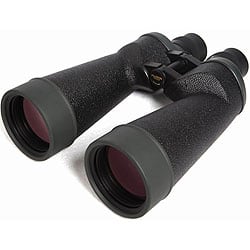Viewing the Pleiades with Binoculars
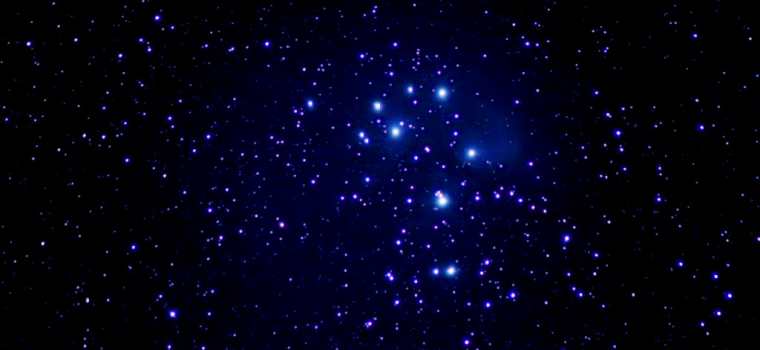
In this guide, the astronomer Philip Pugh takes us through how to find and view the Pleiades star cluster, what to look out for and you can expect to see using different configurations of binoculars:
The Pleiades, or Seven Sisters as they are popularly known, are arguably one of the best-known objects in the night sky. They were certainly well-known before the invention of the telescope.
Depending on the quality of your eyesight and the presence or absence of light at your viewing location, you should be able to see at least six to eight stars. Most astronomers are able to observe them from suburban locations, but even from urban locations, the Pleiades are visible as a misty patch.
Why use Binoculars?
Many people ask or wonder just how many stars can be seen in The Pleiades. The answer to this depends on a number of factors:
What is not obvious is that there are many more “sisters”, with thousands of stars that are invisible to your eyes alone. Using binoculars to see them reveals several stars that you would not notice, otherwise.
Are Binoculars Better than a Telescope?
Due to their large apparent size of two degrees, binoculars are the most suitable type of equipment for viewing the Pleiades. Large telescopes may, theoretically, show fainter stars but they can only show a small part of the cluster. Spotting scopes and small telescopes with lower magnifications are also suitable.
How far is Pleiades from Earth?
They are 2,644 million million miles away. At that distance, only the brighter members are visible, even in powerful amateur telescopes. Many of the stars are red dwarves and there are many sub-stellar objects – brown dwarves and planets.
All the stars are quite young, “only” 100 million years old. Nearly all the brighter stars are near the center of the cluster, giving a false impression of its size. Many fainter stars are present away from the center but are gravitationally bound to the cluster, but they can only be photographed by large professional telescopes. There is some nebulosity in the same area, but the Pleiades is passing through it and there is no association between the two objects.
How do you find The Pleiades?
There are a number of ways of how to find pleiades in the night sky and the method you choose will largly depend on your location and the time of year.
In which constellation are The Pleiades?
They are in the constellation of Taurus but, when low in the east are best found at the feet of Perseus. Except for pre-dawn early risers in early summer, they are visible from just after midnight in August to late April dusk.
To find where Taurus is at any given time, you can use an online planetarium app, such as http://tonightssky.com/MainPage.php. Once, you have found Taurus or Perseus, you can find the Pleiades using the photographs below as a guide:
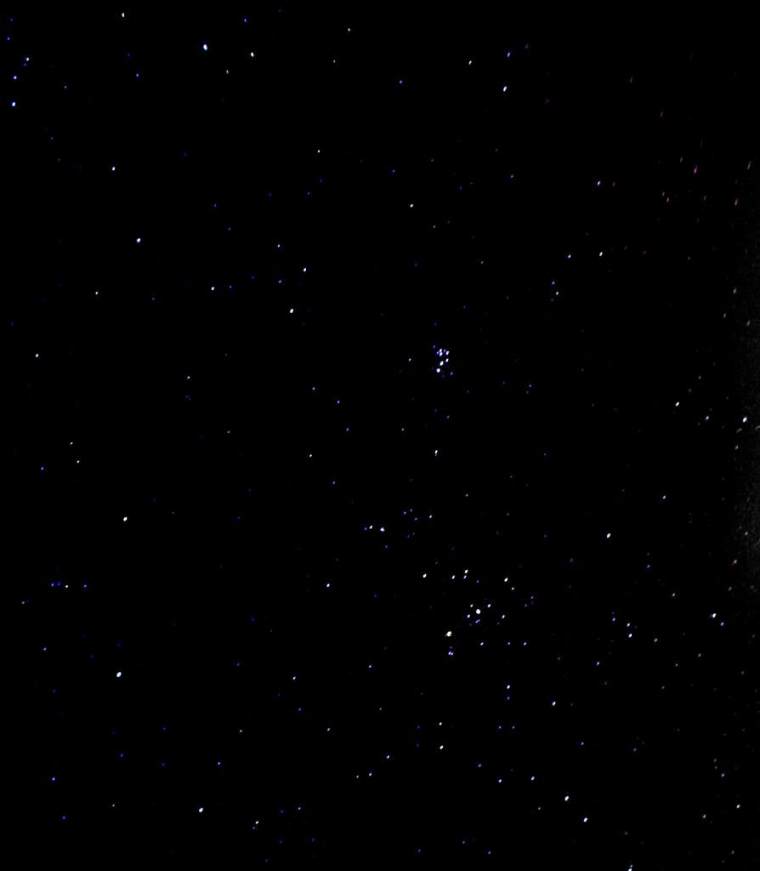
Taurus showing the Pleiades
Taurus
Taurus is also home to another star cluster, the “V”-shaped Hyades. Like the Pleiades, the Hyades make an interesting target for binoculars.
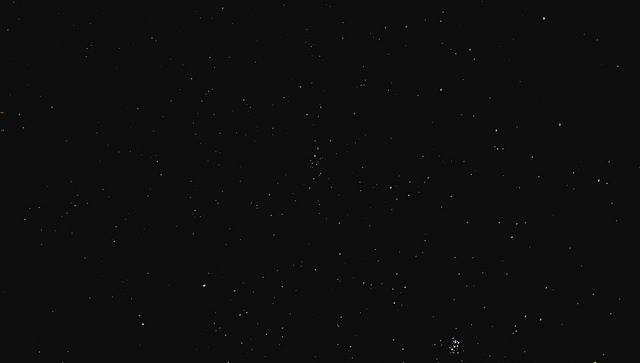
Perseus
Perseus
Perseus contains part of the Milky Way and several interesting objects, such as the Alpha Persei Cluster, which is in the center of the photograph.
Recommended Binoculars for viewing the Pleiades
Any pair of binoculars reveals more stars than are visible with your eyes alone. As for many deep-sky objects, the best binoculars are the largest that you can comfortably hand-hold, however, if you want to use a telescope, then you can go with much bigger, more powerful binoculars.
Magnification isn’t as big a deal as you may think. In many ways, it is more important for it to match the need to keep the exit pupil (aperture divided by magnification) to about a minimum of 4 to 5mm to maintain a bright enough image at night.
The advantage of a higher power is some of the stars are close together, therefore higer magnifications resolve the distance between them and thus will show them as separate stars, rather than a single star.
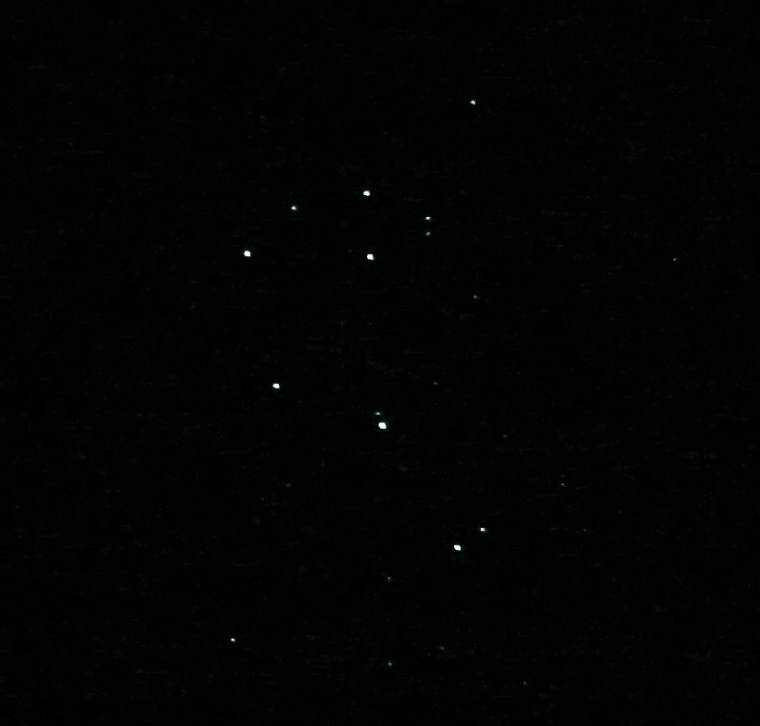
View of The Pleaiades with 30mm binoculars
View through 30mm binoculars
The photograph above shows the central region of how the Pleiades appear in a pair of 30mm binoculars from a suburban sky. The actual view that you see is dependent on:
- The observing location. You will see more stars if the site is away from artificial light and fewer stars from an urban location
- The clarity of the sky. Many nights are apparently “cloudless” but there is often a haze around. Thin cloud does not render the Pleiades invisible but obscures some fainter stars
- Whether or not your eyes are adapted to the dark. On short sessions, they won’t be, and it takes about 20 minutes to fully adapt. An interesting experiment is to look at the Pleiades when you first go out and re-visit them later. You will probably see more stars
- How close the Pleiades are to the horizon. From the southern hemisphere, they never rise far from it
- Whether the sky is twilit or completely dark.

View of The Pleaiades with 50mm binoculars
View through 50mm binoculars
The step-up to 50mm makes many more stars visible. On a clear night, 50 to 70 cluster members is possible, with 30 to 40 being more usual.
As with smaller binoculars, the clarity and darkness of the sky and other factors affect the number of stars that you can see and their brightness. I have observed a lot with 20x50 binoculars but now know that a magnification of 10x or 12x is more suitable for binoculars with an aperture of 50mm.
A high magnification increases the distance between stars, so in some ways are easier to detect, but it also magnifies any distortion and hand movement. A tripod helps with this and most good 50mm binoculars should have a thread for a tripod adaptor these days.
However a very high powered 50mm binocular, like a 20x50 will have a very small exit pupil, making the imahe far less bright in low light and thus not ideal for viewing the stars at night.
50mm binoculars with 10x or 12x magnification are fairly easy for most people to hand-hold and are often a good choice as an astonomy binocular.
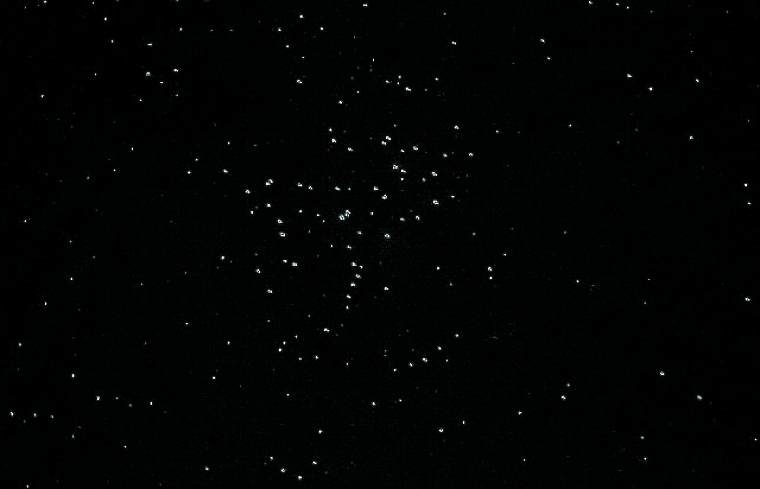
View of The Pleaiades with 70mm binoculars
View through 70mm binoculars
70mm binoculars are not often used for normal terrestrial uses like bird-watching, wildlife observation or hunting so any purchase is normally for astronomical use or for long distance observation.
The view through binoculars of this size, with a magnification in the range of 12x to 16x is simply breathtaking on an average cloudless night, let alone an exceptionally clear one.
I own a pair of 15x70 binoculars and have never counted how many stars I could see but estimate the figure to be around 80. I have steady hands but must admit that the view is not only better through a tripod, but makes it much easier on both the eyes (no image shake) and your arms, especially after longer periods.
Larger, more Powerful Binoculars
I have seen a claim that one can see 103 “sisters” with a pair of 20x114 binoculars. I’ve never tried them but suspect that it could be an underestimate.
There is no question that larger binoculars deliver increasingly better views but once magnification reaches 25x, the field of view reduces to two degrees. This is the apparent size of the cluster, so you need to keep adjusting the position of the binoculars to keep the whole cluster in the field of view. There is the same issue with spotting ‘scopes, where the field of view should be at least two degrees.
More
This guide is part of a binocular astronomy series written for Best Binocular Reviews by Philip Pugh that I highly reccomend you take some time to go through. There are also a number or other astro related articles and guides on BBR which will be of interest:
Guide to Choosing the Best Binoculars for Astronomy
Binocular Astronomy – Brightness & Magnitude
Viewing the Moon with Binoculars by Philip Pugh
Viewing Planets Through Binoculars by Philip Pugh
Guide to Using Binoculars for Astronomy by Philip Pugh
Best 10x50 Binoculars for Astronomy
About Philip Pugh:
Philip describes himself as an “uninteresting person who does interesting things”. He had his first magazine article published in 1980 and has published four books in Patrick Moore’s “Practical Astronomy” series including those shown below.
Like nearly all writers, he has a “day job” and has spent most of his working life as a trainer or technical author. These days, astronomy is his only active interest outside of work and family. He is best known for his interest in the Sun and one of his many activities is to monitor activity using binoculars (with suitable filters). He is also a keen photographer and takes quality photographs using budget equipment.

 Article | Posted by Philip Pugh
Article | Posted by Philip Pugh 



 Categories:
Categories:  Tags:
Tags: 
